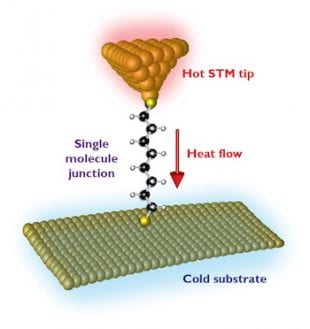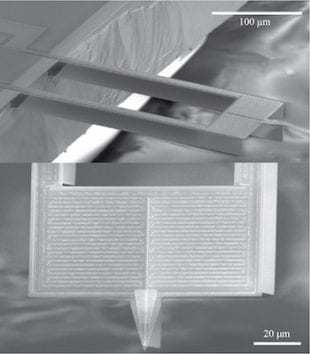Rice postdoc led Nature study to measure thermal conductance through molecules
How much heat can a molecule handle? That’s been a tough question to answer until now, but Longji Cui is on the case.
The Rice University researcher and his former colleagues at the University of Michigan published the first direct experimental measurements of thermal conductance through a single molecule this week in Nature.

A Rice University postdoctoral student led a Michigan study to measure how single molecules conduct heat through a custom probe microscope probe that pulled molecules from a gold surface. Click on the image for a larger version. (Credit: Courtesy of Longji Cui)
Cui, who joined Rice’s Smalley-Curl Institute last year as the J. Evans Attwell-Welch Postdoctoral Fellow, is lead author of the paper that details not only the measurements but the ingenious method he developed to get them.
“We basically demonstrated a single-molecule heat conductor, the smallest heat conductor you can imagine,” Cui said. “We combined a scanning tunneling microscope that can manipulate single molecules and atoms and a ultrahigh resolution sensing technique called picowatt (a trillionth of one watt of power) calorimetry.” That allowed them to measure heat-carrying phonons as they moved through one-dimensional chains of atoms in a single molecule at a resolution of about 80 picowatt.
The central feature of the technique was a nanoscale probe with a gold-coated tip that looked something like a tuning fork with a very short handle. Within the fork was the sensitive calorimeter that measured the energy flow through the molecule stretched between a heated tip and a gold substrate.
“It took a lot of effort to make the experiment possible,” said Cui, for whom the project served as his doctoral thesis. “The measurement of single molecule junctions needs both extreme mechanical stability and extreme temperature sensitivity – and generally, those two are not complementary.”

Longji Cui
For the experiments, a self-assembled monolayer of target molecules was first deposited on a gold substrate. They used the scanning tip to grab one end of a molecule and a piezoelectric mechanism of the scanning tunneling microscope to stretch it — like pulling taffy very, very slowly — at 5 hundredths of a nanometer a second, until the connection broke. “When we stretched the molecule, we monitored the change in the electrical conductance of the molecules, to identify that it’s really a single molecule trapped between the tip and the substrate.”
They discovered that heat-carrying phonons were minimally affected by the length of the molecules — in this case, thiol-terminated alkanes with between 2 and 10 carbon atoms — as they were stretched between the substrate and the gold tip. That was in direct contrast to electrical conductance, which fell exponentially with molecular length.
“Now we understand how phonons behave at a fundamental molecular limit,” Cui said. “Going forward, I imagine we can look for other one-dimensional molecular systems such as long polymers. Theorists have predicted that phonons could transport energy much easier along such long chains of molecules. Plus, the capability of capturing and controlling very small temperature change is important in many areas, like high accuracy time-keeping applications, laser cavity output and thermal cameras.”

Microscope images show the tiny probe used to measure thermal conductance through a single molecule. Click on the image for a larger version.(Credit: Courtesy of Longji Cui)
Cui came to Houston to work with physicist Douglas Natelson, whom he met at a Rice workshop a few years ago and whose own work in single-molecule measurements helped inspire the new study.
Cui’s time at Rice will be short, as he will become an assistant professor of mechanical engineering and materials science and engineering at the University of Colorado, Boulder, in January. But for now, he relishes the chance to work with Natelson.
“Doug is the perfect mentor to help me go forward and look at the research direction I want to take,” Cui said. “He’s a pioneer in Raman spectroscopy of single molecules and nanostructures, and I’m looking to measure how another fundamental particle, photons, and the interaction between photons with electrons and phonons, behave in small molecular devices.”
Read the abstract at https://www.nature.com/articles/s41586-019-1420-z.

